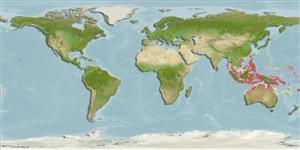>
Ovalentaria/misc (Various families in series Ovalentaria) >
Pomacentridae (Damselfishes) > Pomacentrinae
Etymology: Pomacentrus: Greek, poma, -atos = cover, operculum + Greek, kentron = sting (Ref. 45335).
More on author: Bleeker.
Environment: milieu / climate zone / profondeur / distribution range
Écologie
marin récifal; non migrateur; profondeur 0 - 10 m (Ref. 7247). Tropical; 35°N - 35°S
Indo-West Pacific: Indonesia (Mentawai Islands), Philippines, Palau, Papua New Guinea, Solomon Islands, Vanuatu, north to the Philippines, Taiwan, and Ryukyu Islands. Reported from New Caledonia (Ref. 26587).
Taille / Poids / Âge
Maturité: Lm ? range ? - ? cm
Max length : 7.0 cm SL mâle / non sexé; (Ref. 7247)
Description synthétique
Clés d'identification | Morphologie | Morphométrie
Épines dorsales (Total) : 13; Rayons mous dorsaux (Total) : 14 - 16; Épines anales: 2; Rayons mous anaux: 14 - 15.
Body shape (shape guide): short and / or deep; Cross section: oval.
Adults occur singly or in small aggregations at slightly turbid areas of lagoon and coastal reefs. Feed mainly on benthic algae (Ref. 7247). Oviparous, distinct pairing during breeding (Ref. 205). Eggs are demersal and adhere to the substrate (Ref. 205). Males guard and aerate the eggs (Ref. 205). Diurnal species (Ref. 52881).
Life cycle and mating behavior
Maturité | Reproduction | Frai | Œufs | Fécondité | Larves
Oviparous, distinct pairing during breeding (Ref. 205). Eggs are demersal and adhere to the substrate (Ref. 205). Males guard and aerate the eggs (Ref. 205).
Allen, G.R., 1991. Damselfishes of the world. Mergus Publishers, Melle, Germany. 271 p. (Ref. 7247)
Statut dans la liste rouge de l'IUCN (Ref. 130435: Version 2024-2)
Menace pour l'homme
Harmless
Utilisations par l'homme
Pêcheries: pêcheries vivrières
Outils
Articles particuliers
Télécharger en XML
Sources Internet
Estimates based on models
Preferred temperature (Réf.
123201): 26.9 - 29.3, mean 28.7 °C (based on 1958 cells).
Phylogenetic diversity index (Réf.
82804): PD
50 = 0.5000 [Uniqueness, from 0.5 = low to 2.0 = high].
Bayesian length-weight: a=0.02399 (0.01396 - 0.04123), b=2.94 (2.79 - 3.09), in cm total length, based on LWR estimates for this species & Genus-body shape (Ref.
93245).
Niveau trophique (Réf.
69278): 2.7 ±0.29 se; based on food items.
Résilience (Réf.
120179): Haut, temps minimum de doublement de population inférieur à 15 mois (Preliminary K or Fecundity.).
Fishing Vulnerability (Ref.
59153): Low vulnerability (10 of 100).
🛈
Nutrients (Ref.
124155): Calcium = 161 [78, 256] mg/100g; Iron = 0.87 [0.51, 1.49] mg/100g; Protein = 18.2 [17.0, 19.3] %; Omega3 = 0.111 [0.062, 0.189] g/100g; Selenium = 18.2 [9.7, 36.3] μg/100g; VitaminA = 107 [30, 361] μg/100g; Zinc = 2.12 [1.39, 3.17] mg/100g (wet weight);
